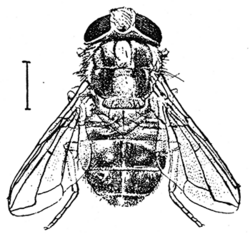Biology:Cordylobia
From HandWiki
Short description: Genus of flies
| Cordylobia | |
|---|---|

| |
| Drawing of adult Cordylobia anthropophaga | |
| Scientific classification | |
| Domain: | Eukaryota |
| Kingdom: | Animalia |
| Phylum: | Arthropoda |
| Class: | Insecta |
| Order: | Diptera |
| Family: | Calliphoridae |
| Subfamily: | Bengaliinae |
| Genus: | Cordylobia Grünberg, 1903 |
| Type species | |
| Ochromyia anthropophaga Blanchard, 1872
| |
| Synonyms | |
|
Stasisia Surcouf, 1914 | |
Cordylobia is a genus of flies from the family Calliphoridae. The larvae of Cordylobia are parasitic on mammals, especially rodents. Two species, C. anthropophaga (the tumbu fly) and C. rodhaini (Lund's fly), also are known as parasites of humans. The adult flies feed on rotting fruits, vegetables, and animal faeces, and are most abundant in the wet season. Like many tropical insects, they are most active in the morning and evening. Cordylobia species are largely confined to Africa, though they have been recorded elsewhere when transported by human travellers.[1]
Species
The genus consists of four species:[2]
- Cordylobia anthropophaga (Blanchard, 1872) - tumbu fly
- Cordylobia rodhaini Gedoelst, 1910 (=ebadiana) - Lund's fly
- Cordylobia roubaudi Villeneuve, 1929
- Cordylobia ruandae Fain, 1953
- Pachychoeromyia praegrandis Austen, 1910 was originally described as belonging to Cordylobia, but is now placed in the monotypic genus Pachychoeromyia Villeneuve, 1920.[2]
References
- ↑ Merilyn J Geary; Bernard J Hudson; Richard C Russell; Andrew Hardy (1999). "Exotic myiasis with Lund's fly (Cordylobia rodhaini)". The Medical Journal of Australia (Australasian Medical Publishing Company) 171 (11–12): 654–655. PMID 10721359. http://www.mja.com.au/public/issues/171_11_061299/geary/geary.html. Retrieved 13 Oct 2008.
- ↑ 2.0 2.1 Rognes, K. (2011). A review of the monophyly and composition of the Bengaliinae with the description of a new genus and species, and new evidence for the presence of Melanomyinae in the Afrotropical Region (Diptera, Calliphoridae). Zootaxa, 2964(1), 1–60. doi:http://dx.doi.org/10.11646/zootaxa.2964.1.1
Wikidata ☰ Q5170122 entry
 |
